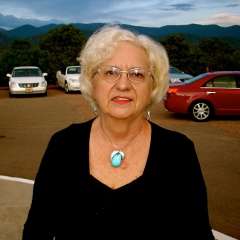Santa Fe Opera presented the same production of Giacomo Puccini’s La fanciulla del West (The Girl of the Golden West) that English National Opera staged at the London Coliseum. Santa Fe Opera has an open backed stage that can show the setting sun over the Jemez Mountains as the show opens, but unfortunately, director Richard Jones did not make use of the advantages the New Mexico city had over London and the result was a horseless “Western” that never showed any of the country’s natural beauty.
Miriam Buether’s sets broke the stage up into cramped rooms. Minnie’s Polka Saloon was a tiny shack outlined and lit by neon, suggesting the availability of electricity. The building did not take up more than a third of the stage and it was hard to fit both soloists and chorus inside. There were rooms on either side of the bar, but the partitions only added to the aura of confinement. Minnie’s cabin, too, was smaller and simpler than necessary but it provided the basics. The Marshall’s Outpost was a much larger building, but it was mainly needed as a backdrop. The action required a hanging tree, but the rope for Dick Johnson's execution appeared magically from somewhere up in the sky.
Nicky Gillibrand’s costumes did not nail down the period to a specific decade, but Minnie wore ankle length dresses and boots that related tangentially to the California Gold Rush, and her Native American servant also wore a long cloth dress. The men wore an assortment of pants that included jeans. Almost everyone wore a holster with a gun in it. Stage Director Jones and Choreographer Lucy Burge created an interesting scene in the first act that showed miners learning to dance.
Among Puccini operas, Fanciulla relates to Madama Butterfly and Turandot. Calling for a large orchestra, Puccini’s wrote Fanciulla in a symphonic style. Conductor Arturo Toscanini called it a "great symphonic poem". Puccini uses folk songs, Spanish rhythms and Native American chants that relate to the culture of the opera's setting. Puccini used these sonorities in an impressionistic manner that brings to mind music of Maurice Ravel, Richard Strauss, and even, at times, Claude Debussy. Conductor Emmanuel Villaume brought out Puccini’s innovations and, with his complete command of Santa Fe Opera’s superb orchestra, he insured the unhindered flow of each of scene. There were a few times, however, that the orchestral sound blotted out some of the singing.
Portraying the role of Minnie for the first time, Patricia Racette showed the dramatic timbre that has grown with her voice over the last few years. Her diction was understandable and she molded Minnie into a barroom angel who sang with strong sonorities. She even made some of us believe a bar owner would teach reading using the Bible. British tenor Gwyn Hughes Jones’s warm, resonant voice made him a shining star in this hardscrabble opera. Although his timbre sounded more lyrical than dramatic, he sang with well focused sound that carried across a sizeable orchestra. His coppery-bright tones made his rendition of the Act III aria he sings contemplating death, “Ch’ella mi creda,” a pearl of opulent beauty. A large man, he could have been a nasty highway robber, but he showed an appealing tenderness with Minnie.
Mark Delavan was a thoroughly evil Sheriff Jack Rance and Gillibrand even had him wear a black hat. Although he tried to show his better side to Minnie, he could not compete with Johnson. Delavan sang with dark burnished tones that underscored both his authority and his uncouth intentions. The lyrical beauty of tenor Allan Glassman’s voice made him a standout as Nick the Bartender. Apprentice Mezzo Kristen Choi was a pregnant Wowkle who sang her small part with sweet tones accented by delicious low notes. Craig Verm was a resonant Sonora and Raymond Aceto a stalwart Wells Fargo Agent.
Santa Fe Opera’s chorus, directed by Susanne Sheston, is made up of apprentices and for Fanciulla only the men had to report. It isn’t easy to form a musically united chorus out of a group of trained soloists, but Sheston does that every year. The tiny “Polka Saloon” was a tight fit for even half of her group, but even when hemmed in, they sang with well-balanced sonorities. Despite a few drawbacks, Puccini’s La fanciulla del West (The Girl of the Golden West) is a fine opera that American audiences rarely see. The music is well performed and I think everyone who can get to Santa Fe should see it.




